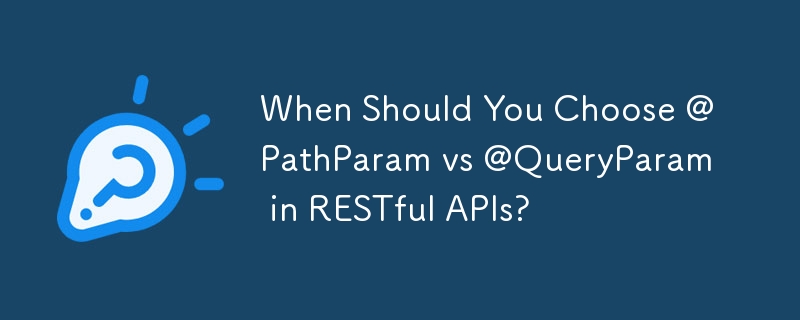When Should You Choose @PathParam vs @QueryParam in RESTful APIs?
Oct 30, 2024 am 07:44 AM
Best Practices for @PathParam vs @QueryParam Usage in RESTful APIs
While the differences between @PathParam and @QueryParam in Java are well-documented, this article explores best practices for their usage to effectively differentiate information patterns in RESTful APIs.
PathParam for Entity Hierarchy Navigation
PathParam can be employed to represent hierarchical categories within a resource structure. This approach aligns with the drill-down nature of entity hierarchies, where PathParam values lead the request to specific entities within the hierarchy. For instance:
/Vehicle/Car?registration=123 /House/Colonial?region=newengland
QueryParam for Instance Attributes
Conversely, QueryParam can be reserved for specifying instance attributes that further delineate the target entity. This convention enables the isolation of instance-specific characteristics without altering the path hierarchy. Consider the following example:
@GET
@Path("/employee/{dept}")
Patient getEmployee(@PathParam("dept")Long dept, @QueryParam("id")Long id) ;In this case, the request locates employees within a specific department, with the optional query parameter filtering the results by employee ID.
Consistency and Convention
While there is no universally accepted convention, the adherence to certain best practices can enhance the consistency and usability of RESTful APIs. Some widely adopted guidelines include:
- Confine mandatory parameters to the path.
- Employ query parameters for optional filtering and sorting.
- Model resource hierarchies using PathParam.
- Reserve QueryParam for instance-specific attributes.
Summary
Utilizing @PathParam for entity hierarchy navigation and @QueryParam for instance attributes not only improves the clarity and organization of RESTful API URLs but also conforms to common industry practices. By embracing these best practices, developers can design APIs that are both user-friendly and efficient.
The above is the detailed content of When Should You Choose @PathParam vs @QueryParam in RESTful APIs?. For more information, please follow other related articles on the PHP Chinese website!

Hot Article

Hot tools Tags

Hot Article

Hot Article Tags

Notepad++7.3.1
Easy-to-use and free code editor

SublimeText3 Chinese version
Chinese version, very easy to use

Zend Studio 13.0.1
Powerful PHP integrated development environment

Dreamweaver CS6
Visual web development tools

SublimeText3 Mac version
God-level code editing software (SublimeText3)

Hot Topics
 Top 4 JavaScript Frameworks in 2025: React, Angular, Vue, Svelte
Mar 07, 2025 pm 06:09 PM
Top 4 JavaScript Frameworks in 2025: React, Angular, Vue, Svelte
Mar 07, 2025 pm 06:09 PM
Top 4 JavaScript Frameworks in 2025: React, Angular, Vue, Svelte
 How does Java's classloading mechanism work, including different classloaders and their delegation models?
Mar 17, 2025 pm 05:35 PM
How does Java's classloading mechanism work, including different classloaders and their delegation models?
Mar 17, 2025 pm 05:35 PM
How does Java's classloading mechanism work, including different classloaders and their delegation models?
 How can I use JPA (Java Persistence API) for object-relational mapping with advanced features like caching and lazy loading?
Mar 17, 2025 pm 05:43 PM
How can I use JPA (Java Persistence API) for object-relational mapping with advanced features like caching and lazy loading?
Mar 17, 2025 pm 05:43 PM
How can I use JPA (Java Persistence API) for object-relational mapping with advanced features like caching and lazy loading?
 Iceberg: The Future of Data Lake Tables
Mar 07, 2025 pm 06:31 PM
Iceberg: The Future of Data Lake Tables
Mar 07, 2025 pm 06:31 PM
Iceberg: The Future of Data Lake Tables
 How do I use Maven or Gradle for advanced Java project management, build automation, and dependency resolution?
Mar 17, 2025 pm 05:46 PM
How do I use Maven or Gradle for advanced Java project management, build automation, and dependency resolution?
Mar 17, 2025 pm 05:46 PM
How do I use Maven or Gradle for advanced Java project management, build automation, and dependency resolution?
 Spring Boot SnakeYAML 2.0 CVE-2022-1471 Issue Fixed
Mar 07, 2025 pm 05:52 PM
Spring Boot SnakeYAML 2.0 CVE-2022-1471 Issue Fixed
Mar 07, 2025 pm 05:52 PM
Spring Boot SnakeYAML 2.0 CVE-2022-1471 Issue Fixed
 Node.js 20: Key Performance Boosts and New Features
Mar 07, 2025 pm 06:12 PM
Node.js 20: Key Performance Boosts and New Features
Mar 07, 2025 pm 06:12 PM
Node.js 20: Key Performance Boosts and New Features
 How do I implement multi-level caching in Java applications using libraries like Caffeine or Guava Cache?
Mar 17, 2025 pm 05:44 PM
How do I implement multi-level caching in Java applications using libraries like Caffeine or Guava Cache?
Mar 17, 2025 pm 05:44 PM
How do I implement multi-level caching in Java applications using libraries like Caffeine or Guava Cache?







